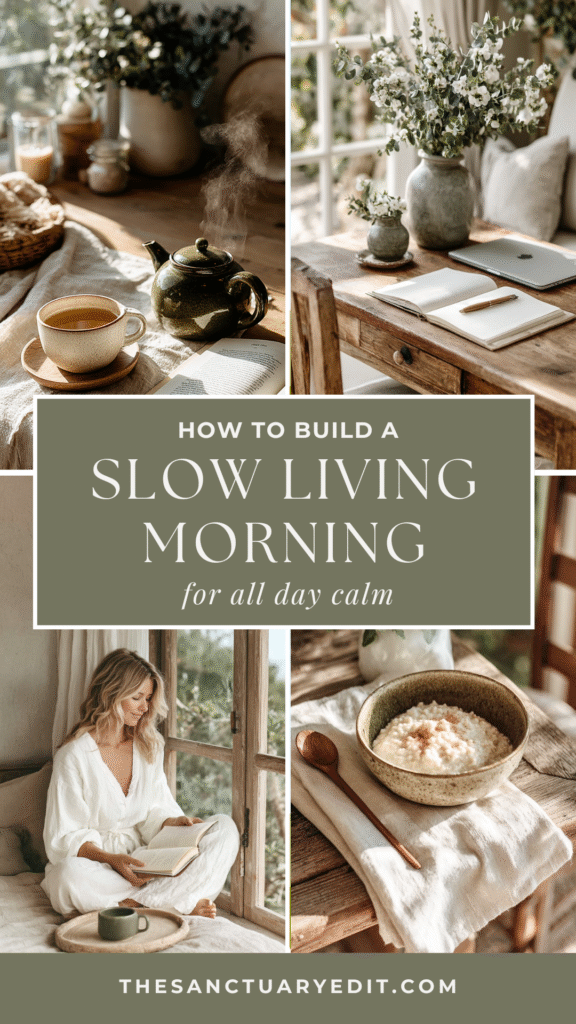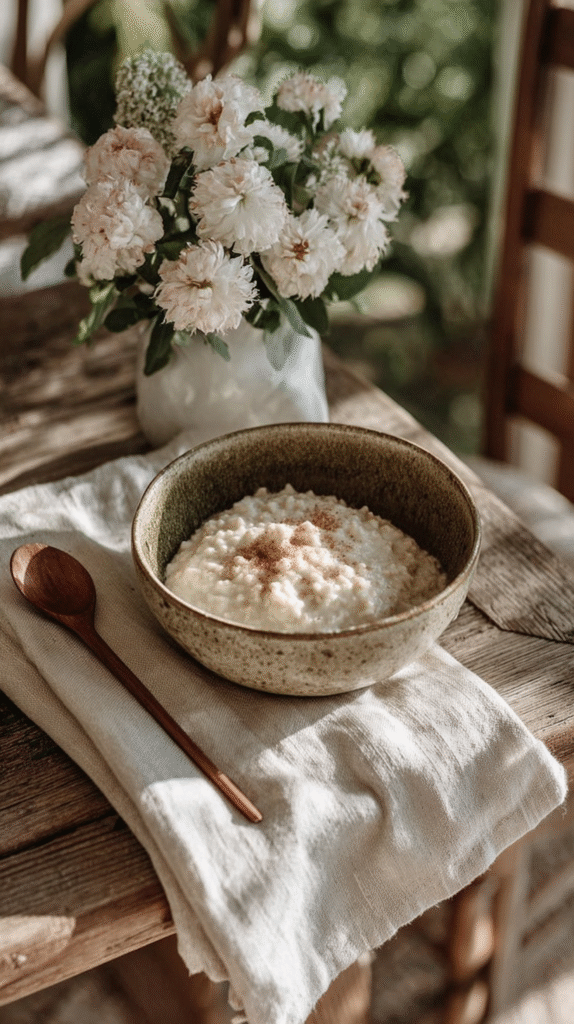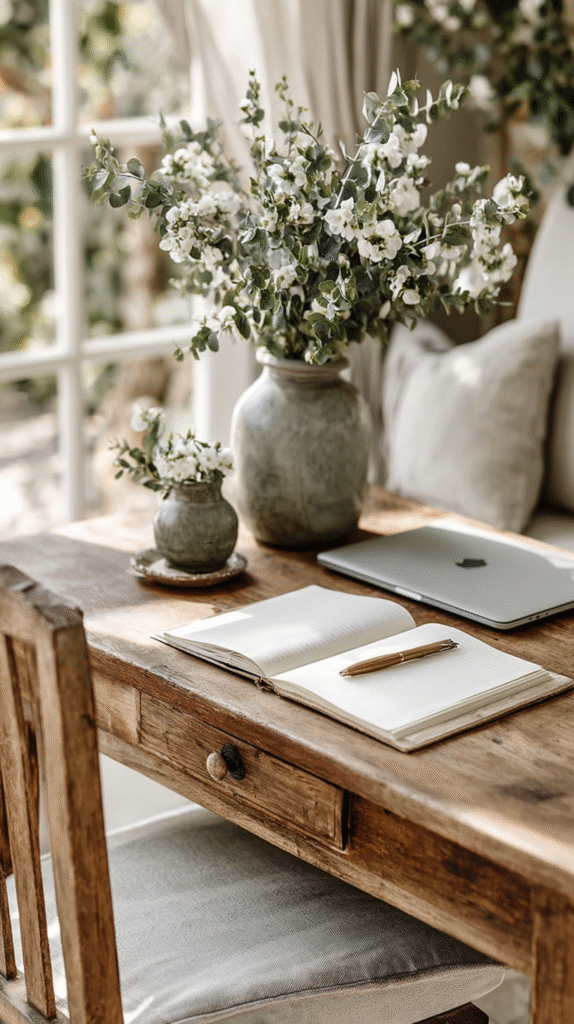This post may contain affiliate links, including those from Amazon Associates. If you make a purchase through these links, I may earn a commission at no additional cost to you. Learn more about our affiliate policy.
Some mornings feel like they begin before you do. The alarm cuts through the dark, your mind floods with tasks, and your body is already bracing for the day. But mornings don’t have to start in fight-or-flight.
With a few thoughtful edits, they can become an invitation to soften, connect, and move through your day with grounded ease.
A slow morning routine is less about doing more and more about creating space for your nervous system to settle before the noise begins.
Why Slow Mornings Matter
The way you begin your morning shapes the rhythm of your entire day.
When you start in a rush, your body holds on to that tension, carrying it into your work, your relationships, and even your rest. But when you begin with presence, you create a buffer between yourself and the world’s pace.
Research shows that small morning rituals like breathing, mindful movement and natural light activate the parasympathetic nervous system, helping you feel calmer and more focused.
You don’t need a long or elaborate routine. What matters is intention. A few slow moments that belong entirely to you.
If you’re easing into a slower rhythm, this guide on 5 easy slow living habits you can start in 10 minutes offers simple practices to bring calm into ordinary moments.

The Foundation of a Slow Morning
Every slow morning routine rests on a few guiding principles.
Start small. You don’t have to overhaul your life. Begin with one simple practice that feels supportive. Consistency will calm your body far more than perfection ever could.
Honor your energy. Some mornings you’ll have time for stillness, others only a quiet breath before opening your laptop. Both count.
Engage your senses. Soft light, warm tea, fresh air, the texture of linen beneath your feet—these cues tell your body it’s safe to relax.
Prep the night before. Choose clothes, tidy your surfaces, and place what you’ll need within reach. Reducing decisions keeps your mind spacious when you wake.
Delay technology. Give yourself a buffer before opening your phone. The first minutes of the day set your emotional tone. Protect them.
Creating Your Morning Menu
A slow morning isn’t a checklist to complete. It’s a menu of grounding options you can choose from based on how you feel.
1. Conscious breathing
Sit upright, close your eyes, and take three to five slow breaths. Let the exhale lengthen slightly longer than the inhale. This simple rhythm activates calm in your nervous system.
2. Gratitude drop-in
As you sip your tea or coffee, name one thing you’re grateful for. It can be as small as sunlight through the window or the quiet hum of morning. Gratitude softens the edges of thought and reminds you what’s already good.
3. Gentle movement
Stretch, roll your shoulders, or take a brief walk outside. Movement helps your body wake naturally and releases any tension from sleep.
4. Journaling or intention setting
Write one line about how you want to feel today. Calm, clear, steady. Let your words guide your attention throughout the day instead of focusing on outcomes.
5. Sensory ritual
Light a candle, open a window, or place your hands around a warm mug. Invite your senses to arrive in the moment. The goal isn’t ritual for its own sake but to anchor yourself through simple sensory connection.
6. Nourishing breakfast
Eat slowly. Notice the texture, the warmth, the scent. When you eat with awareness, digestion improves and your mind naturally slows down.

7. Morning pause before screens
Keep your phone in another room or turn off notifications until after your morning rhythm. You’ll notice how much quieter your inner world feels when you begin with your own presence instead of everyone else’s.
You don’t need to do all of these at once. Choose two or three that call to you, and let them evolve as your life does.
Structure for Different Rhythms
The beauty of slow living is adaptability. Here are three ways to shape your mornings around time and energy, not pressure.
If you have five minutes
- Sit up and take three slow breaths.
- Stretch your arms and roll your shoulders.
- Sip water or tea before touching your phone.
If you have fifteen minutes
- Move gently—walk, stretch, or breathe.
- Write a short intention in your journal.
- Prepare a simple, nourishing breakfast.
- Let natural light fill the room before opening screens.
If you have thirty minutes or more
- Start with breath or meditation.
- Move your body with yoga or stretching.
- Make a sensory ritual, light a candle, open the window, listen to soft music.
- Eat mindfully and reflect on one thing you’re grateful for.
The length of time doesn’t determine the benefit. Presence does. Even brief calm moments can shift your physiology and steady your emotions for the rest of the day.

Prepare the Evening Before
Slow mornings often begin the night before. When your space feels calm, your nervous system can rest deeply, making the next morning easier to meet with softness.
- Tidy one surface before bed like your nightstand, kitchen counter, or entryway. For a quick practice, read my post on the 15-minute saily decluttering routine.
- Lay out comfortable clothes so dressing is effortless.
- Prepare breakfast items ahead, like overnight oats or pre-washed fruit.
- Dim the lights an hour before bed to signal rest.
- Write down tomorrow’s top priorities so your mind can release them.
These small preparations mean you wake to clarity instead of clutter, creating a natural sense of peace before your feet touch the floor.
When Life Feels Too Busy
Even with good intentions, there will be mornings that resist slowness. You oversleep. The children need you. Deadlines crowd in. That’s okay.
In those moments, return to one breath. Place a hand on your heart, feel your feet on the floor, and inhale softly. This pause alone resets your body’s rhythm. A slow morning isn’t about perfection—it’s about remembering you always have access to calm, no matter how full life feels.
Reframing What “Productive” Means

Many of us have been taught that productivity equals worth. But slowness can be its own quiet form of efficiency. When your nervous system is calm, your focus sharpens and your energy becomes steadier throughout the day.
You make fewer rushed decisions, recover from stress more quickly, and relate to others with more presence.
Let your slow morning be the foundation for all-day calm. When you move from regulation rather than reaction, you conserve energy for what truly matters.
A Mindset of Gentleness
Think of this routine not as self-improvement but as self-relationship. You’re learning to meet yourself with care at the threshold of each new day. There’s no perfect formula, only curiosity. Some mornings will feel peaceful, others will still hold tension. Keep showing up anyway.
You might notice that over time, you no longer wake in panic. Your breath deepens naturally. The light through the window feels softer. The day begins to move around you, not against you. That is the quiet gift of a slow morning routine, it rewires how you experience time itself.
Closing Reflection
Tomorrow, try one small act of slowness before you reach for your phone. Step outside and notice the air. Stretch in silence. Sip your tea without multitasking. Each morning you claim a moment of calm, you’re teaching your body that peace is available.
A slow morning is not about adding rituals. It’s about remembering that how you begin determines how gently you move through everything else.


